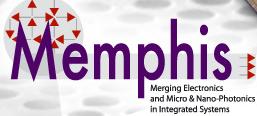Merging electronics and Micro-nano PHotonics in integrated systeMs (Memphis)
The limitations of present electronics require a new massive converging technology based on complementary characteristics of "micro- and nano-electronics" and "micro- and nano-photonics", utilizing the best of both technology worlds. A low cost combination of the processing power of classical CMOS IC technology, the high frequency capabilities of modern High Frequency (HF) electronics and the large bandwidths offered by integrated photonics creates the technology for novel broadband miniaturized electronic-photonic devices. This would open the way to major new applications for the use of light, in medical diagnostics, for healthcare, entertainment, telecommunications, tracking and positioning. Underlying technologies are Ultra-fast Signal Processing, Terahertz Imaging, Broadband Communication Technologies, Sensor Technology, Raman-spectroscopy, Laser Imaging and Light Sources.
The goal of the MEMPHIS project is the research and development of an integrated electronic-photonic technology platform (Silicon logic, HF, nano-electronics and photonics) to provide a broad range of multi-function miniaturized electronic-photonic devices.
Workpackage: smart antennas
The aim is to arrive at compact imaging systems at 94 GHz and above, with very high resolution, using on-chip phased array antennas. Aspects are smart antennas, efficient up/downconversion (mixers), signal routing and conditioning, data acquisition and processing.Technologies used are THz-Silicon varactors, micromachined antennas (multilayer microstrip patch arrays), SiP approach.
Workpackage: Integrated mm-wave radar
For more information, see the
project homepage.

Project data
| Researchers: | Leo de Vreede, John Long |
|---|---|
| Starting date: | July 2007 |
| Closing date: | December 2012 |
| Funding: | 18000 kE; related to group 2334 kE |
| Sponsor: | SmartMix |
| Partners: | 22 partners. Workpackage smart antennas: Lionix, UT, TUE, NLR, ASTRON, TUD, TNO. |
| Contact: | Leo de Vreede |